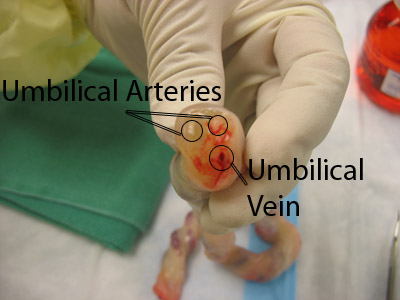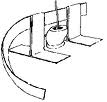-
Hide blocks
- Full screen
- Standard view
Critical Procedure - Umbilical vein catheterisation
Back to Critical Procedures - Index page
Home
For all procedures, ask yourself, 'does this need to be done 'now vs later'? And should this be done by 'me vs someone else?' Very often the answers will be 'now' and 'me' - so read on!
Umbilical Vein Catheter insertion
Description
How to insert an umbilical vein catheter for emergency resuscitation. NB.This article does not address inserting UVC's for longer term use.
Indications
The need for vascular access in the newborn (and up to a week of life).
Contraindications
This is usually an emergency procedure with no contra-indications in this setting.It is argued that intraosseous access is quicker and it may be more appropriate if readily available.
Equipment
- Personal protective equipment
- Sterile gloves
- Sterile drapes
- Skin prep eg. chlorhexidine
- Umbilical catheter 3.5F or 5F
- Iris forceps/small curved haemostat
- Scalpel
- Scissors
- Umbilical tape
- Suture and needle driver
- Adhesive tape
- Intravenous tubing and 3-way stopcock
- 3ml or 5ml syringe containing N. Saline
Procedure

- Prepare
- Prime the umbilical catheter by attaching a 3-way tap to it and connecting a syringe containing saline to one of the ports. Push the salline so that a small amount flows from the other end of the catheter.
- Have all the instruments and equipment ready
- Keep warm
- Ensure the infant is kept warm - ideally under a well lit radiant heater.
- Keep it clean
- Given the nature of neonatal resuscitation this procedure is usual somewhat time pressured. Do your utmost to ensure sterility.
- Prep the skin with chlorhexidine or the agent that your facility uses.
- Place sterile drapes to create a sterile field.
- Place the umbilical tape
- around the base of the cord. Tie a loose, single knot, so that it can be tightened later.
- If you have an assistant
- you may ask them to lift and thus support the cord, with small haemostats or similar, whilst you are working. This is not essential.
- Cut the cord
- Lift up the end of the cord and cut it cleanly across, with the scalpel, about 2cm from the base. If there is a lot of bleeding (unlikely), tie the umbilical tape, somewhat firmly to achieve haemostasis.
- Examine the cord
- identify the vein (thin walled, larger, often oozing some blood or with a clot within it, most often at the 12 o'clock position) and the 2 (sometimes just one) arteries (thick walled, smaller, firmer).
- Dilate the end of the umbilical vein
- use the iris forceps/small curved haemostat
- Insert the catheter
- grasp near the tip and gently insert it into the vein. Do not force the catheter at any point. Direct it slightly cephalad, which is the vein's natural route.
- the depth should not be more than 2-4 centimetres from the abdominal wall. Ideally, it should be just 1-2 cm beyond when blood can be aspirated using the attached syringe.
- If blood cannot be aspirated then flush gently with saline via the syringe and try aspirating gently again. If blood still cannot be aspirated then try advancing the catheter just a little bit further or withdrawing it slightly.
- Secure the catheter

- tie the umbilical tape firmly but not tightly at the base of the cord.
- pass a suture through the base of the cord (distal to the umbilical tape and away from the vein/catheter). Tie the suture around the catheter firmly, but with out occluding it.
- make a tape bridge (or make a support out of a cut upside down medicine cup) to support the catheter and increase its' attachment to the infant.
- Administer medications/fluids via the 3-way tap. Umbilical vein catheter insertion
Back to Critical Procedures - Index page
Home
Last modified: Thursday, 19 May 2022, 3:20 PM